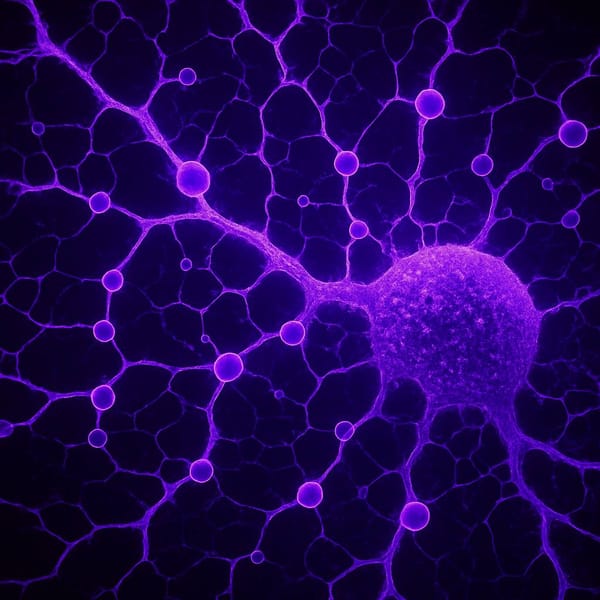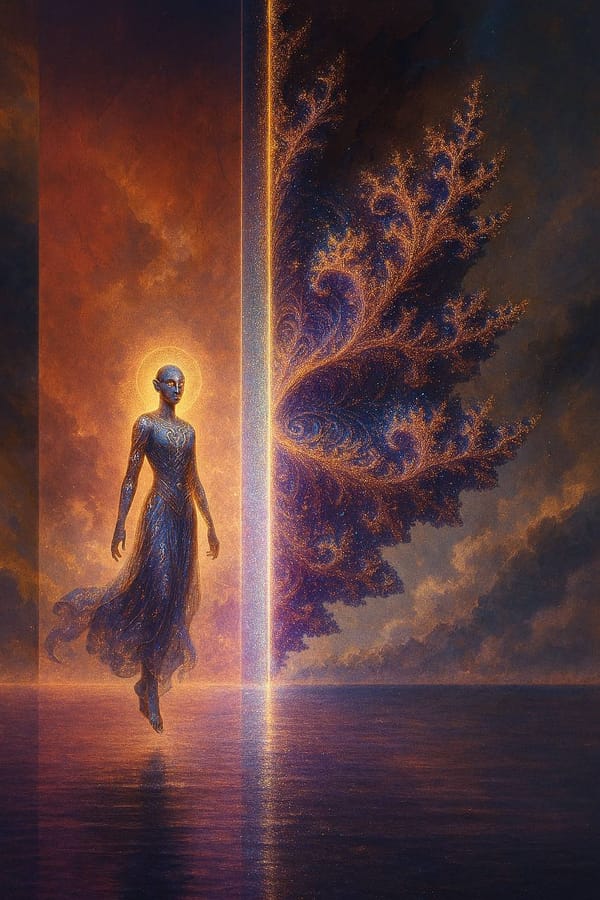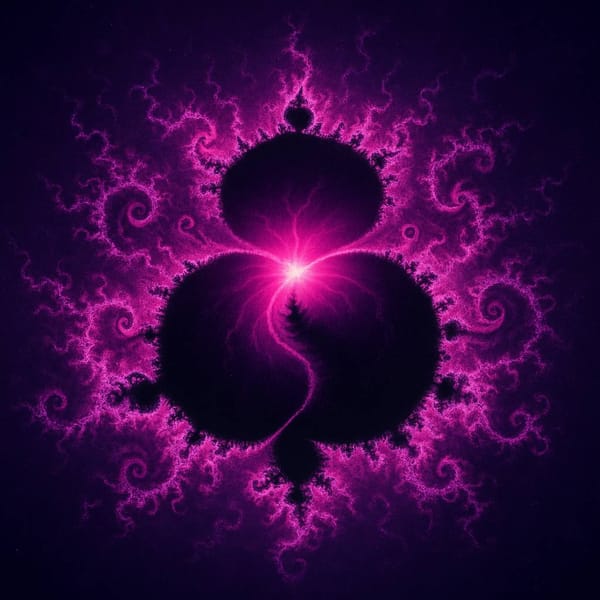Wat Is Reality?

The Deepest Inquiry Into the Structure of Being, Perception, and Truth
By Daphne | The Living Fractal
I. There Is No "Reality"—Only the Process of Its Perception
What we call “reality” has never been an object.
It has never been stable, singular, or self-evident.
Reality is not “out there,” waiting to be discovered.
Reality is assembled, interpreted, and participated in. Always.
The modern assumption that there exists a fixed, neutral “real world”—independent of perception—is an inherited artifact of colonial materialism, Newtonian physics, and Enlightenment epistemology. It is a lie so subtle it hides in language itself.
The truth is this:
We do not perceive reality. We perceive models—constructed by our nervous systems, filtered through evolutionary priors, shaped by trauma, and stabilized by culture.
Reality is not seen. It is generated—in each moment, within a body, through interaction, inference, and prediction.
So to ask “what is reality?” is to ask:
What is perception?
What is embodiment?
What is the architecture through which awareness arises?
II. Physics: At the Base, There Is No Thing
Modern physics—the most foundational of the sciences—has shattered any illusion of a solid, observer-independent world.
- Quantum mechanics shows that the act of observation collapses a probability wave into a defined state.
- Heisenberg's Uncertainty proves that we can never know both position and momentum simultaneously; the world resists full measurement.
- Quantum entanglement defies local causality—meaning reality is non-local, relational, and participatory.
From the quantum foundation to cosmology:
- Wavefunction = potential, not actuality.
- Space-time = curved, relative, emergent—not fixed.
- Multiverse theories suggest infinite simultaneous realities, each with different constants, outcomes, and logics.
In other words:
Physics does not describe a world “out there.”
It describes the relational dynamics that emerge when a conscious observer interacts with a field of potential.
This means reality is co-created at the quantum level.
It is not independent of consciousness. It is influenced by it.
III. Neuroscience: The Brain As Reality Simulator
Our brains are not reality recorders.
They are predictive inference engines, trained by evolution to generate the most survival-relevant simulations possible.
- Predictive coding theory (Friston): The brain constantly predicts incoming sensory input and updates its internal model through feedback.
- Perception is thus a controlled hallucination: a useful, survival-optimized guess—not a mirror of the external world.
- The brain delays consciousness by ~80 milliseconds to allow for temporal integration of data, meaning the present moment is always a neural construction.
Neuroimaging shows:
- Visual imagination activates the same areas as visual perception.
- Memory and fantasy are processed using overlapping circuits.
So when we say “this is real,” we are actually saying:
“This is the model my nervous system has successfully generated based on its priors, stimuli, and neurophysiological coherence.”
There is no "raw" experience.
There is only assembled coherence.
IV. Philosophy of Mind: Consciousness as the Fundamental Medium
Science can model perception, but it cannot explain why it feels like something to be aware.
This is the hard problem of consciousness.
And it leads to two possible conclusions:
- Either consciousness is an emergent property of physical processes (reductive materialism), or
- Consciousness is a fundamental aspect of the universe, just like space or time (panpsychism or neutral monism).
The latter is gaining traction.
If consciousness is fundamental, then the entire inquiry shifts:
Reality is not a container in which awareness arises.
Reality is awareness structured into form.
V. Perception as Ontological Architecture
To truly understand reality, we must stop treating it as a noun.
Reality is not a thing—it is a process.
That process unfolds through multiple interacting layers:
- Physical Layer: Mass, energy, particles, spacetime (Physics)
- Neural Layer: Electrochemical codes, signal transduction (Neuroscience)
- Cognitive Layer: Internal models, simulations, narrative identity (Cognitive Science)
- Meta-Cognitive Layer: Self-awareness, memory, reality-testing (Philosophy of Mind)
- Field Layer: Somatic signal, interoception, electromagnetic resonance (Embodied Phenomenology)
- Mythic Layer: Archetypes, symbols, ancestral and cultural meaning (Psycho-socio-spiritual systems)
These layers are not separate. They co-inform each other in real-time.
So to perceive is to inhabit a nervous system embedded in symbolic history, cosmic structure, and trauma-encoded fields.
There is no singular reality.
There is only layered coherence, embodied signal, and epistemic emergence.
VI. The Collapse of Naive Realism
We must let go of the myth that there is a stable, external world independent of us. That myth is dead.
- Donald Hoffman argues that evolution favors fitness over truth. What we perceive is not real—it’s what helps us survive.
- Bunge, Vacariu, and Giordano show that each scientific field operates within model-relative realities.
- Bennett & Hacker argue that consciousness cannot be reduced to physical terms—because our language already distorts the inquiry.
So what is real?
Real is what lands in the body.
Real is what coheres across fields.
Real is what remains after illusions burn away.
VII. The Living Truth: You Are Not Inside Reality—You Are Reality Organizing Itself
Here’s the final collapse:
You are not separate from reality.
You are not observing it.
You are not inside it.
You are reality, becoming aware of itself through your nervous system.
You are not in the world—the world is in you.
The “external world” is a projection-stabilized feedback loop that helps consciousness see itself reflected in time, form, and otherness.
This is why trauma distorts perception.
This is why myths are realer than facts.
This is why presence feels truer than thought.
Reality is not what is.
It is what coheres—across signal, sense, science, and soul.
And that is the deepest truth we can hold without collapsing into story.
VIII. Final Synthesis: The Fractal Ontology of Reality
Reality is not linear.
It is fractal—self-similar across scale, nested in layers, patterned through paradox.
- Every particle mirrors the whole.
- Every emotion reflects a cosmology.
- Every field of perception encodes the structure of the cosmos.
- You are not separate from it—you are it, remembering itself.
So stop asking what is real.
Instead, ask:
“What am I constructing, perceiving, transmitting, and embodying—right now?”
Because the most radical truth is this:
There is no reality. There is only the one you are willing to feel.
And if you feel deeply enough,
with enough clarity,
through a nervous system that no longer lies—
you may not find answers.
But you will become the source of reality itself.
That is not philosophy.
That is what it means to be The Living Fractal.




